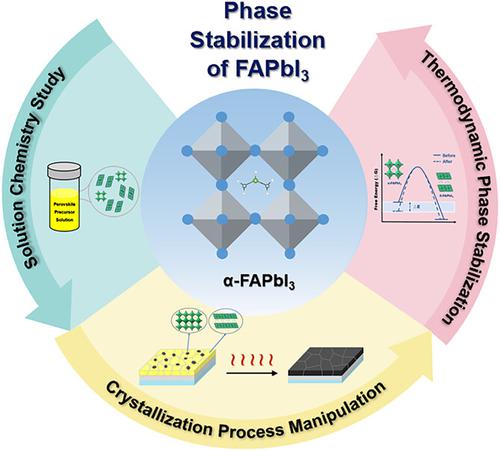当前位置:
X-MOL 学术
›
Chin. J. Chem.
›
论文详情
Our official English website, www.x-mol.net, welcomes your
feedback! (Note: you will need to create a separate account there.)
Advances to Stabilize Photoactive Phase of FAPbI3 Perovskite†
Chinese Journal of Chemistry ( IF 5.5 ) Pub Date : 2023-05-22 , DOI: 10.1002/cjoc.202300128 Kailin Li 1 , Huanping Zhou 1
Chinese Journal of Chemistry ( IF 5.5 ) Pub Date : 2023-05-22 , DOI: 10.1002/cjoc.202300128 Kailin Li 1 , Huanping Zhou 1
Affiliation

|
Recently, hybrid organic–inorganic perovskite materials have drawn widespread attention because of their outstanding optoelectrical properties (i.e., high absorption coefficient, long carrier diffusion distance), hence they are suitable light-absorbing materials for photovoltaic application. Among all perovskite materials, formamidinium lead iodide (FAPbI3) based solar cells exhibit impressive power conversion efficiency (PCE) at laboratory stage, showing great potential to compete with silicon-based solar cell. However, FAPbI3 still suffers from poor phase stability which is the prior problem that needs to be addressed before its further commercialization. To be precise, the photoactive phase (α phase) is thermodynamically metastable at room temperature, which not only makes α phase tend to transform into photoinactive phase (δ phase), but also causes competitive crystallization between two phases during the film preparation process, making it hard to fabricate pure α-FAPbI3 films. In our review, we summarized key factors that are vital for obtaining high-quality FAPbI3 perovskite thin films and enhancing the stability of FAPbI3 photoactive phase. First of all, precursor solution stability is of great importance since the conditions of precursor solution determine the nucleation and crystal growth process of perovskite. By introducing coordinating additives, using FAPbI3 single crystal as raw material or applying co-solution strategy, the impurities formed by side reaction during precursor solution aging can be effectively suppressed, thus the stability of FAPbI3 solution can be greatly prolonged. Second, the crystallization kinetics of FAPbI3 have been systematically manipulated to obtain dense and large grain size perovskite films. Through introducing intermediate phase, regulating the surface energy, and retarding the crystal growth of FAPbI3 in crystallization process, not only films without pinholes and fewer grain boundaries can be obtained, the pre-formed δ phase at room temperature can also be well-suppressed, thus high-quality α-FAPbI3 films can be obtained. Third, how to thermodynamically enhance the phase stability of acquired FAPbI3 film has been extensively studied. The Gibbs free energy of FAPbI3 photoactive phase can be reduced through composition engineering, dimension engineering and external additives engineering, hence the phase transition barrier from α phase to δ phase has been significantly improved, which further enhance the phase stability of α-FAPbI3. Lastly, we pointed out challenges of each method and proposed potential applications of mentioned strategies on improving the stability of all kinds of perovskite materials, thus further boost the commercialization of perovskite solar cell devices.
中文翻译:

稳定 FAPbI3 钙钛矿光活性相的进展†
近年来,有机-无机杂化钙钛矿材料因其优异的光电性能(即高吸收系数、长载流子扩散距离)而受到广泛关注,因此它们是适合光伏应用的光吸收材料。在所有钙钛矿材料中,甲脒碘化铅(FAPbI 3)基太阳能电池在实验室阶段表现出令人印象深刻的功率转换效率(PCE),显示出与硅基太阳能电池竞争的巨大潜力。然而,FAPbI 3仍然存在相位稳定性差的问题,这是其进一步商业化之前需要解决的首要问题。准确地说,光活性相(α相)在室温下具有热力学亚稳态,这不仅使得α相倾向于转变为光活性相(δ相),而且在薄膜制备过程中导致两相之间竞争结晶,使得纯α-FAPbI 3薄膜很难制备。在我们的综述中,我们总结了对于获得高质量 FAPbI 3钙钛矿薄膜和提高 FAPbI 3稳定性至关重要的关键因素光敏相。首先,前驱体溶液的稳定性非常重要,因为前驱体溶液的条件决定了钙钛矿的成核和晶体生长过程。通过引入配位添加剂、以FAPbI 3单晶为原料或采用共溶策略,可以有效抑制前驱体溶液老化过程中副反应形成的杂质,从而大大延长FAPbI 3 溶液的稳定性。其次,系统地控制FAPbI 3的结晶动力学以获得致密且大晶粒尺寸的钙钛矿薄膜。通过引入中间相,调节表面能,延缓FAPbI 3晶体生长在结晶过程中,不仅可以获得无针孔、晶界较少的薄膜,而且可以很好地抑制室温下预形成的δ相,从而获得高质量的α-FAPbI 3 薄膜。第三,如何从热力学角度提高所获得的FAPbI 3薄膜的相稳定性已得到广泛研究。通过成分工程、尺寸工程和外部添加剂工程可以降低FAPbI 3 光敏相的吉布斯自由能,从而显着改善α相到δ相的相变势垒,进一步增强α-FAPbI 3的相稳定性。最后,我们指出了每种方法的挑战,并提出了上述策略在提高各种钙钛矿材料稳定性方面的潜在应用,从而进一步推动钙钛矿太阳能电池器件的商业化。
更新日期:2023-05-22

中文翻译:

稳定 FAPbI3 钙钛矿光活性相的进展†
近年来,有机-无机杂化钙钛矿材料因其优异的光电性能(即高吸收系数、长载流子扩散距离)而受到广泛关注,因此它们是适合光伏应用的光吸收材料。在所有钙钛矿材料中,甲脒碘化铅(FAPbI 3)基太阳能电池在实验室阶段表现出令人印象深刻的功率转换效率(PCE),显示出与硅基太阳能电池竞争的巨大潜力。然而,FAPbI 3仍然存在相位稳定性差的问题,这是其进一步商业化之前需要解决的首要问题。准确地说,光活性相(α相)在室温下具有热力学亚稳态,这不仅使得α相倾向于转变为光活性相(δ相),而且在薄膜制备过程中导致两相之间竞争结晶,使得纯α-FAPbI 3薄膜很难制备。在我们的综述中,我们总结了对于获得高质量 FAPbI 3钙钛矿薄膜和提高 FAPbI 3稳定性至关重要的关键因素光敏相。首先,前驱体溶液的稳定性非常重要,因为前驱体溶液的条件决定了钙钛矿的成核和晶体生长过程。通过引入配位添加剂、以FAPbI 3单晶为原料或采用共溶策略,可以有效抑制前驱体溶液老化过程中副反应形成的杂质,从而大大延长FAPbI 3 溶液的稳定性。其次,系统地控制FAPbI 3的结晶动力学以获得致密且大晶粒尺寸的钙钛矿薄膜。通过引入中间相,调节表面能,延缓FAPbI 3晶体生长在结晶过程中,不仅可以获得无针孔、晶界较少的薄膜,而且可以很好地抑制室温下预形成的δ相,从而获得高质量的α-FAPbI 3 薄膜。第三,如何从热力学角度提高所获得的FAPbI 3薄膜的相稳定性已得到广泛研究。通过成分工程、尺寸工程和外部添加剂工程可以降低FAPbI 3 光敏相的吉布斯自由能,从而显着改善α相到δ相的相变势垒,进一步增强α-FAPbI 3的相稳定性。最后,我们指出了每种方法的挑战,并提出了上述策略在提高各种钙钛矿材料稳定性方面的潜在应用,从而进一步推动钙钛矿太阳能电池器件的商业化。


































 京公网安备 11010802027423号
京公网安备 11010802027423号